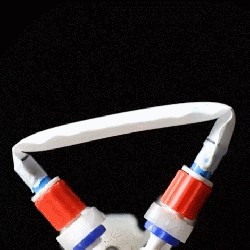Your average 3D printer is just a nozzle shooting out hot plastic while being moved around by a precise robotic mechanism. There’s nothing stopping you replacing the robot and moving around the plastic-squirting nozzle yourself. That’s precisely what [3D Sanago] did to produce this cute little robot.
The beginning of the video sets the tone. “First we create the base that will become the robot vacuum’s body,” explains [3D Sanago]. “I quickly and precisely make a 15 x 15 cm square almost as if I were a 3D printer.” It’s tedious and tiring to move the 3D printing pen through the motions to build simple parts, but that’s the whole gimmick here. What’s wild is how good the results are. With the right post-processing techniques using an iron, [3D Sanago] is able to produce quite attractive plastic parts that almost justify the huge time investment.
The robot itself works in a fairly straightforward fashion. It’s got four gear motors driving four omniwheels, which let it pan around in all directions with ease. They’re under command of an Arduino Uno paired with a multi-channel motor driver board. The robot also has a servo-controlled arm for moving small objects. The robot lacks autonomy. Instead, [3D Sanago] gave it a wireless module so it could be commanded with a PS4 controller. Despite being referred to as a “robot vacuum,” it’s more of a general “cleaning robot” since it only has an arm to move objects, with no actual vacuum hardware. It’s prime use? Picking up socks.
We’ve seen [3D Sanago]’s fine work before, too. Video after the break.
Continue reading “3D Pen Used To Build Cleaning Robot That Picks Up Socks”








![[Austin Blake] sitting on line follower cart in garage](https://hackaday.com/wp-content/uploads/2025/05/line-follower-1200.jpg?w=600&h=450)









